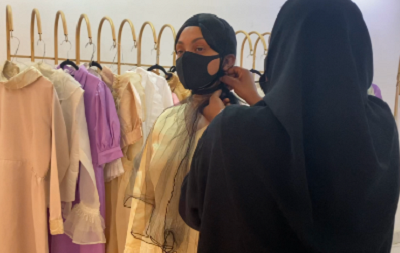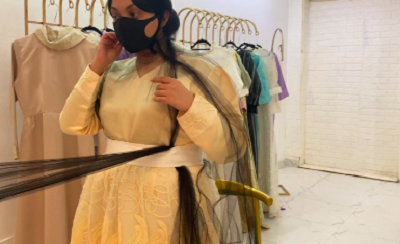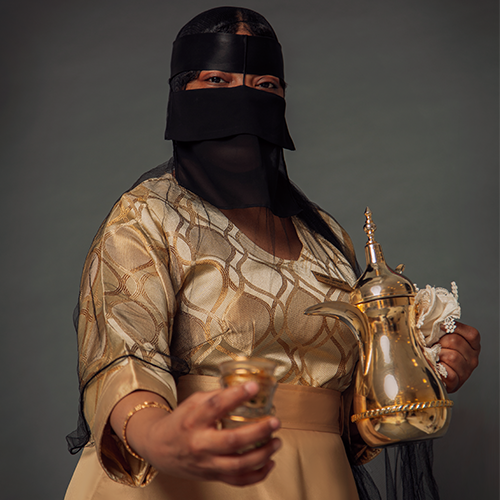This is the first in a two-part series presented by Saudi artist
Elham Dawsari where she shares her work in the fields of urban design, feminism and social theory as well as speculating on life in a pre-internet Saudi Arabia. In this post, she shares the story behind her photo essay Subabat: Tales of Sisterhood in Hospitality.
Who is Subabat?
Subaba’ is a common term in Saudi Arabia and the Gulf region and refers to the working women in the hospitality field. The Subabat prepare and serve Arabic coffee (now nationally rebranded as Saudi coffee), tea, desserts and other alimentary treats. The root Arabic word of Subaba is subb and translates to 'to pour'. Clients hire Subabat for their services in various all-female social events and especially in wedding ceremonies. The term also includes Subabat who work in private houses and palaces. Subabat is a window into Saudi history and society since its founding days, albeit being marginalised communities, under-researched and visually undocumented. In 2021, I started researching, interviewing and photographing them, resulting in a 20-page photo essay and a video. Subaba in a modern iteration of their uniform
The Spark
As a young kid visiting Riyadh in the early 90s, in a hugely closed-off society back then, I attended my first weddings. It was easy to take note of the class disparity despite an outward cultivated similarity between the older conservative female relatives and guests, and the Subabat. It turns out that the Mother Subabat in Riyadh based the earlier iterations of their uniform on the traditional dress of the older Saudi women of the high-class society they initially catered to. Around 12 years old, I began associating Subabat with muted beauty. To my mind, they were like a silent film - mesmerising but unsung. Their ability to pass on a rich professional and personal philosophy as they catered to the guests, without uttering a word, struck me and fixated the spark.

A model dressed by Subaba. Outtakes from the video “Subaba Appearane & Uniform“ accompanying the photo essay.
Glammed up Socio-economic Gap
Each summer, vis a vis wedding season, I noticed that the Subabat developed their appearance and a more collective presence. Stealthy as they were, they saliently coexisted with the glitzy opulent decor and mash of women from various social spheres of Saudi-Khaleeji intense 90s glam. Yet against the hall’s austere continental high walls, housing silhouettes of floating updos and silky trails, it was the Subabat’s traditional sensibility for me, albeit seemingly outnumbered, that filled the air with a temporary gravity. They pulled at my attention, and raised non-coherent questions, building up intrigue throughout the years. Subaba pouring Saudi coffee
The Subconscious Impact of Mothers
In your typical aunts’ and cousins’ post-wedding review, my mother blesses her, like many, quite seriously, measuring the excellence of a wedding through various fixed factors. Near the top of the list, were two important female vocations; hospitality and live folklore music, respectively the Subabat and “Taqaqat”. As I got older, I would steal longer glances as they served me Saudi coffee, in the hopes of later sketching them when I got home. My photographic memory consistently failed me, and I felt helpless to know that it would be some time before I considered suggesting photographing conservative marginalised Saudi women as an option. Subaba serving black and mint tea
The Conscious Impact of Cultural Producers
In 2021, I was invited to apply to a 6-month digital residency with Sawtasura, by Saudi curator Tara
Tarā: A kind of turban traditionally worn by Lori speaking ethnic women over their scarves. Aldughaither. An online platform archiving the vocal heritage of Saudi women. I immediately thought of the accompanying female vocation to folklore music in weddings; Subabat. I agreed, knowing the difficulties. It was my chance to finally put in a committed effort, and research the social and economic origins and factors which birthed and maintained the profession of Subabat in Riyadh. Assistant Subaba with cup carrier
The Labour of Documenting Marginalised Communities
Having not found published literature in local libraries and academic research on Subabat, I began asking friends and family members for contact numbers of the Subabat they have hired throughout the years, as well as looking myself through online forums. Most of the Subabat I called almost immediately refused to participate. Mainly due to a misunderstanding of the research purposes, as a result of the social and spatial isolation brought on by classism, a century in the making. Among the women who eventually partook in the interviews was Master Subaba Um
‘Um: (Arabic: mother), a sign of respect or formality, women are not addressed by their own names, rather as mother of, then adding the name of the eldest son as in Um Mohammed. Also can mean: with, for example (‘um mishakhiṣ) meaning with gold embellishment. Fahad, (Moudhi Alsa’doon), who was recently hired by my family for my brother's engagement and wedding parties back then. It is safe to say, as much as Um
‘Um: (Arabic: mother), a sign of respect or formality, women are not addressed by their own names, rather as mother of, then adding the name of the eldest son as in Um Mohammed. Also can mean: with, for example (‘um mishakhiṣ) meaning with gold embellishment. Fahad was a sensation in many online forums, even in neighbouring gulf countries, so she was in real life.Barely Breaking Barriers
I went on to tell her that she played a critical role in the overall joyous ceremonies, cheering us in a series of ululations and dance floor praises, while she prepared her brilliant coffee and supervised the catering. “I praise Allah”, she said, “for enabling me to perform my duties and bring joy to people in their happiest of times. Tell me, dear, do you have another wedding you want me to cater for?” I explained my research. Upon her confusion and questioning, I elaborated and attempted to clarify my intentions and how the purposes of the research would benefit society at large. I was still met with hesitancy. It was my personal experience with Um
‘Um: (Arabic: mother), a sign of respect or formality, women are not addressed by their own names, rather as mother of, then adding the name of the eldest son as in Um Mohammed. Also can mean: with, for example (‘um mishakhiṣ) meaning with gold embellishment. Fahad at my brother’s wedding and several online search indicators of her impact on society and the profession of Subabat that kept me persistent. Top: ‘Bukhnaq’, black sheer fabric wrapped around head and body Bottom: ‘Shageesah’, front hair extension, braided for maintaining
Silos of Internalised Silence
Many of the older Subabat alive today are illiterate or have only had some basic schooling. Still, younger and more formally educated Subabat, also expressed quick refusal to participate in a study and “speak about the private homes and families” they have worked in or catered for. Disinterested in hearing my attempts to correct this misunderstanding, one Subaba hung up after refusing to share other contacts. I switched up my strategy, and spent several more weeks and months expressing sincere over-due praise of their tremendous role and effect, not only on Saudi society and its history but on parts of the Gulf region as well. I stressed to them that it is our responsibility to actively honour them, not only for preserving tradition but adapting it to constant steep social changes for close to a century. I hit a chord with the Master Subabat when I brought up their collective attempts as professionals and a force of sisterhood, in how they stood against the monopoly of big hospitality companies in the 90s and early 2000s, with their cheaper foreign labour and threat of cultural washing. One of many research insights I owe to my mother, who usually shared her strong opinions and analysis of Subabat’s profession and background throughout the years. As they opened up and shared details, I listened in awe and stated the obvious. “You are the true independent woman. You generationally empowered yourselves long before any collective conscious calls for, or echoes of concrete female empowerment.” 
Photographing Invisible Women
No physical interviews were conducted due to the partial lockdown. So, proposing to photograph them was an even more awkward quest. Coming from a conservative Saudi family who valued politeness, it felt unbecoming to insist when they obviously refused to be photographed. I retreated and resorted to sketching other ideas for other artistic mediums, only proving to be futile forms of procrastination. After weeks of overthinking the impact of a photoless essay on Subabat, I gathered some grit and called them again. I reiterated and stressed that they will be modelling as themselves and paid to do so, with a framed signed copy for each. If comfortable, they can wear the burqa during the shoot to conceal their identities. I pledged to dedicate 25% of the prints’ proceeds to their daughters’ education. I emphasised the importance of photography for such an essay. How it would help in reaching a wider segment of society who will, or may have lost touch with Subabat's presence and history, or have had none at all. How it could indirectly help their businesses.It was an overwhelming accomplishment when I got a small number of Subabat to eventually agree to both the research interviews and photography. Subabat preparing behind the scenes
The Travelling Archives
The support I had via Sawtasura curating a digital residency and exhibition, my own sisterhood of friends and relatives, and most importantly, the interviewed women of the hospitality field, were critical in producing this research and accompanying photos and video. All of which helped further its reach and impact. I learned that Subabat has increased their commissioned daily wage since, from the manager of the printing house I go to for prints of the Subabat photographs. Ahmed, who coincidentally was raised by Master Subabat, explained to me once that the mass online circulation of the photo essay boosted their demand. Students, academics and professors in the region, Europe and the US, have reached out to include or build on the photo essay in their curricula and research.Sharing the photo essay online with a mass of people before formally publishing it, helped me in filling the gap between oral and written history. I continue to gather dispersed first-hand experiences and knowledge of Subabat from a segment of older Saudi women who read the essay and reached out. It is a valuable byproduct of unconventional art/research in form and distribution, and I am grateful for it. More on the Lives of Saudi Women
As an artist and writer, I tend to curate the hidden stories of people and places in Riyadh and their relation to each other. More specifically, I analyse the human condition of Riyadh’s pre-internet or marginalised women of middle and lower economic classes, and how spatial, economic and social classifications influenced their lives and behaviours leading to today.
Prior to researching
Subabat, I spent a year studying clay and sculpting figurines. My subjects were socially and economically conservative Saudi women of the 1980s-1990s living in Riyadh. A time where very little of them is photographed, if at all.
Read more about this research in my next post.
Elham Dawsari. Photographer: Abdullah Alshehri
About the author
ELHAM DAWSARI is a self-taught sculptor, interdisciplinary conceptual artist and writer based in Riyadh, Saudi Arabia. Her work is underpinned by research in the fields of urban design, feminism and social theory as well as speculating on life in a pre-internet Saudi Arabia. Born and raised in the midwest and east coast of the United States, Dawsari moved back to Riyadh when she was in high school in the mid-1990s. A tireless explorer, her need to experience various forms of art expression, coupled with her professional practice in business, journalism, advertising, creative writing and translation, has attributed to her resourceful and holistic approach to art-making as an independent artist.
Dawsari explores the human condition of Riyadh’s 1980s and 90s pre-internet women of middle and lower economic classes, and how economic and social classifications influenced their lives and behaviours. She also focuses on the relation between urban landscaping and human behaviour specific to these women. The artist collects professional and domestic accounts of working and non-working women, and how concepts of money, spatiality and mobility factor into them. As this ongoing study is a personal journey for the artist herself, having grown up in the 90s in Riyadh, she seeks to capture the sentiment in these women’s memories of a visually undocumented, pre-internet time in conservative Saudi households specifically.
The artist deep dives into her family’s own archive of memories, stories and photo albums, as well as resources in literature and text, and conducts one-on-one interviews of her subjects for wider research and documentation. Through her personal research and artwork, she encourages filling in the chasmic gaps of visual and written history as it pertains to Saudi women’s daily lives. She aims to reinstate a generation of older women into the current discourse of a new cultivated Saudi in a proud tribute to the women and girls of a recent past deeply contrasting with today’s thriving and youthful social scene.
Artist Statement - Elham Dawsari
Read more about the Subabat photo essay project here.
*the copyright to all images belongs to Elham Dawsari. Reproduced here with permission







